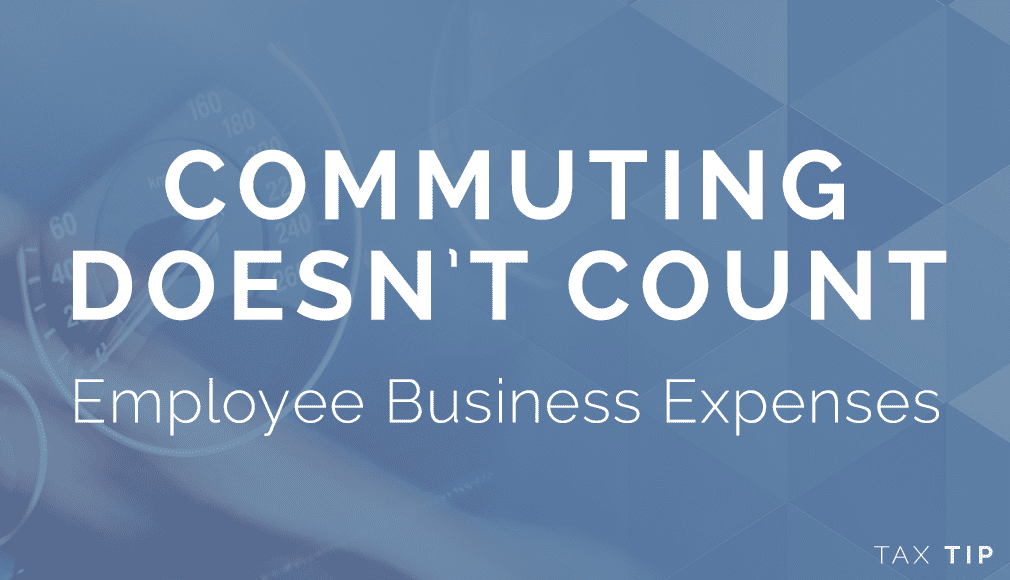
The IRS is currently cracking down on unreimbursed employee business expenses reported by individual taxpayers. Recent court cases have been decided in favor of the IRS when taxpayers cannot provide sufficient and complete evidence to substantiate deductions.
Employees often incur work-related expenses that are not reimbursed by the employer. These may be deducted as itemized deductions on Schedule A, but there are many rules about what type of records must be kept and which types of expenses are deductible. Any expenses claimed must be ordinary and necessary. This means expenses which are common and accepted in the taxpayer’s business that are also helpful and appropriate.
Vehicle expenses are a common employee business expense. A taxpayer drives his own vehicle while performing part of his job. Think about the office manager that goes to the bank to make a company deposit and to the office supply store to buy some copy paper. An insurance salesman may drive to his client’s home to discuss policies and coverage. A doctor may go to the hospital to do rounds in the morning and later drive to his office to see patients in the afternoon. If an employee uses his own car for business purposes, and the employer does not reimburse him, he can deduct the car expenses. Generally, this can be done either by the standard mileage rate or by using actual expenses.
The standard mileage rate is a published annual cents per mile rate. Many people prefer using this method because the record keeping is pretty simple. Simply calculate total business miles, multiply by the standard mileage rate, and that is the deduction. Actual tolls and parking fees could be deducted in addition, since these are not expenses that relate to the vehicle itself.
Actual vehicle expenses are things like gas, lease payments, repairs, insurance, depreciation, and vehicle registration fees. A taxpayer would determine total expenses and total business miles driven. The percentage of business to total miles is applied to the total expense to determine the deductible amount. In many cases, vehicle expenses can be calculated under both methods and the one that results in the higher deduction can be used.
Taxpayers must be careful when determining what constitutes business use of a personal vehicle. Commuting doesn’t count! That means that driving from your home to your office and back is not business use. If you work in more than one location during the day, the miles between the two locations are business miles. For the doctor mentioned above, the miles from home to the hospital and from the office back to home are nondeductible commuting miles, but the miles from the hospital to the office are business miles. Likewise, for the office manager, the miles from the office to the bank and to the office supply store are business miles. The insurance salesman may spend his entire day “on the road” and never go to his regular office. This means that the miles from his home to the first appointment of the day are commuting miles and the miles between all the customers throughout the day are business miles. The miles between his last appointment of the day and his home are commuting miles.
What are accurate records? If a taxpayer deducts travel, entertainment, gift, or transportation expense, he must be able to prove certain elements. A taxpayer needs to keep accurate, contemporaneous records of expenses. This means written proof in an account book, diary, log, or similar record. Documentary evidence to support each element should also be kept. The contemporaneous requirement means that the records must be created at or near the time of the expense. Making up an entire year’s worth of mileage logs after receiving an audit notice is not contemporaneous. This is one of the reasons a taxpayer lost a court case earlier this month. Basically, for each expense, the taxpayer should record the amount, date, place, and essential character of the expense. Simply listing the miles driven to a business location may not be enough. The records should also indicate the business reason for the trip, and include any documentary evidence that may support that. For instance, the insurance salesman may have a new contract signed by the customer on the date of the trip, and the office manager may have the receipt from the office supply store. The doctor would have records of the notes made during his rounds at the hospital as well as records of the patients seen back at the office to prove that he was in both work locations on a given day.
There are numerous apps and software programs that can help to track business use of a vehicle, but it can also be as simple as keeping a small notebook in the car. A taxpayer can jot down the beginning and ending odometer reading for a trip, then list the date, address, and business purpose. Sometimes, a written explanation of the business purpose may not even be required. Imagine a sales representative that travels the same established route each Tuesday to check the amount of his products in the same customers’ locations. He can document the trip one time, and then indicate on subsequent routes that it his usual Tuesday route.
Although keeping accurate records may seem like an onerous task, not doing so could result in large tax assessments. Recent court cases ruled that taxpayers without adequate records were denied the deductions, which resulted in a not only a large tax bill, but also accuracy-related penalties based on substantial understatement of tax. Don’t let legitimate business expenses get denied just because it was too much trouble to keep the records. Talk to your CPA to find out if your records are sufficient.
Contact us for guidance and application to your individual situation →

Associate Partner
Julie has over 20 years of experience in public and private accounting, representing varied clientele including the medical, legal, and real estate industries and trusts.
View Julie's Bio →